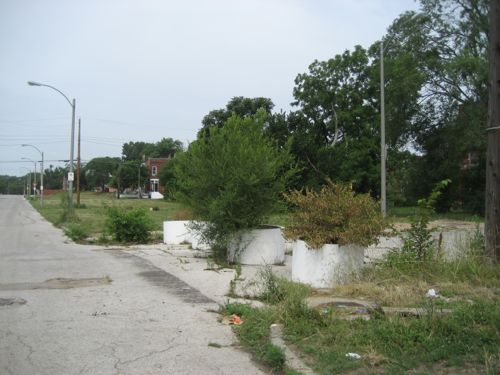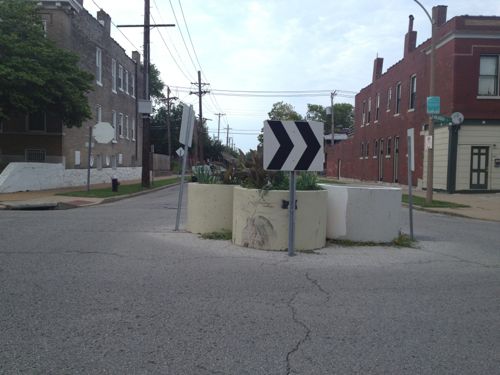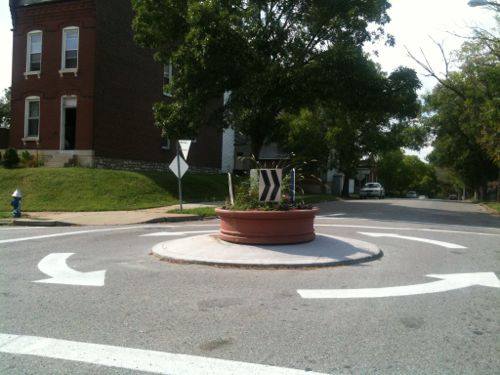‘Schoemehl Pots’ Traffic Circles Roundabouts
Vince Schoemehl served as mayor for three 4-year terms, from 1981-1993. He’ll be remembered in history for a number of things, but perhaps mostly for giving us “Schoemehl Pots,” concrete sewer pipe sections filled with dirt.

Lately they’ve been used in a way that calms traffic while keeping the grid intact: the Schoemehl Pot Roundabout Traffic Circle!


The roundabout traffic circle shown at the bottom takes a considerable investment compared to a few sewer pipes filled with dirt, but the results are dramatically different too. I just know I’ve never seen a Schoemehl pot installation that didn’t make me cringe. Can we stop using them to block streets and create makeshift roundabouts traffic circles?
With limited resources, when it is determined that a roundabout is needed, would you suggest delaying the installation until the funds for a roundabout per photo 3 are available, or would you prefer use of sewer pipe? And, in your mind, what kinds of “results” does the poured-in-place roundabout provide vs the precast sewer pipe roundabout? Functional results or aesthetic results? Both? Actually, the look and functional performance of the roundabout shown in photo 3 could fairly easily be achieved by pre-casting the “disc” portion (in two pieces perhaps due to weight), setting it on the existing street surface without benefit of excavation or footing, holding it in place using 1-1/2: rebar dowel driven several feet into the subgrade (much like railroad tie retaining walls and precast parking lot wheelstops are held in place) , and then setting a red-stained concrete pot filled with soil and plants on top of it. Sure, it would be more expensive than the sewer pipe, but much less costly than the poured-in-place option.
The problem with what you state is that without street surface excavation the plants will die inside, then they become nothing more than weed pots.
MMMMMMMMMMMmmmmmmmmmmm! (?????) I cannot imagine that plants can’t live in a 2′-6″ deep planter, well drained, totally isolated from street subgrade. And I can’t imagine that the red pot shown in photo 3 is integral with the poured-in-place island. Sorry, I suppose i disagree with your statement.
Then learn about plants. They will and do bake inside those planters, they also freeze. Our weather and pollution is too harsh in middle of the street to survive alone by being dropped anywhere. Perennials put out deep roots to survive a number of living conditions. Annuals require upkeep and replacement.
The good thing about engineering and construction is that there are very few absolutes!
Just as Dunkin-Donuts are made with holes, so too can precast discs be made with holes. The circumference of the hole can be traced onto the street surface, and the street pavement and the subgrade within the area of the circle can be EASILY removed to allow for the additional volume of planting soil to which you refer……provided it is so important. Not convinced yet that it is…..but I am convinced that the precast alternative (even with the additional street excavation) is the more cost-effective alternative to provide this “traffic circle”. The pot, then, could be fabricated much like a sewer pipe with open opposing ends, but with a decorative fascia, perhaps, then epoxy grouted into a reglet left in the top perimeter of the precast void. (My wife has two clay planters sitting on our back porch. Each planter is approximately 14″ tall. Both are filled with plants, both sit directly in the sun most of the day, both are victims of loving neglect….yet both look great. I can’t recall that the soil has ever been replaced or even renewed. I suppose plant selection has something to do with the explanation!..or maybe I need to check to verify if the plants might be plastic!)
Well I’ve seen some Schoemehl round abouts that are decorated and I’ve seen some (on Waterman comes to mind) where it is a fountain, I do think that they offer a quick solution to a number of problems. The problems though are 3 fold….1) drivers do not know how to use them 2) the city lacks maintaining them and 3) local residents think the city will take care of them (see #2 ).
Until #1 is met, then # 2 and # 3 wont happen.
I know that up east (Mass and RI) roundabouts are well developed and maintained. Many are small parks with some type of memorials, but then the surrounding sidewalks and land are shaped to match the roundabout, making for a much better and easier to use experience.
They seem to work well in residential parts of Seattle, because they’re not a tacky quick fix the area residents maintain the plantings.
I didn’t say they didn’t work. I said that drivers don’t know how to use them AND they are lacking upkeep. To see examples look to the zoo entrance for people that don’t know how to use one, and for upkeep….just pick any of them in the neighborhoods. I would be for a lot more roundabouts and a lot less stop signs IF they were well maintained.
Let me rephrase, drivers in Seattle generally understand how to use them.
Many people confuse older styles of circular intersections with modern roundabouts. East coast rotaries, large multi-lane traffic circles (Arc D’Triumph), and neighborhood traffic circles are not modern roundabouts. If you want to see the difference between a traffic circle, a rotary (UK roundabout) and a modern roundabout (UK continental roundabout), go to http://tinyurl.com/kstate-RAB to see pictures. And here’s another site that shows the difference between an older rotary and a modern roundabout: http://tinyurl.com/bzf7qmg
The FHWA (http://tinyurl.com/fhwaRAB) has a video about modern roundabouts that is mostly accurate (http://www.youtube.com/watch?v=uhHzly_6lWM ).
Neither a Schoemehl Pot nor the concrete obstruction in the third photo placed in the middle of an existing city intersection creates a roundabout. A real roundabout requires a much bigger center section: http://en.wikipedia.org/wiki/Roundabout
Yes, looks like traffic circle is the better term: http://trafficcalming.org/measures/traffic-circles/
We already have a standard form of traffic calming in the Lou – it’s called the 4-way stop. Adding an element to the center of an existing intersection does little to further “calm” traffic (although completely blocking an intersection with Schoemehl Pots does), but it does increase the likelihood that a neighborhood will have another weed-filled, unmaintained “public element” / piece of streetscaping. The only thing an obstruction in the center of an intersection might do is make it easier to change from stop signs to yield signs on all four corners. Bulb-outs are a much better solution.
The 4-way stop is ineffective as a speed control measure (see: http://www.ite.org/traffic/documents/aha99b49.pdf) and contributes to our air quality problems.
The fundamental issue is are we talking about speed control or access control? Once you get off of arterial and collector streets, the primary perpetrators of speeding in any neighborhood are people who live in the neighborhood! My understanding is that Schoemehl Pots were installed primarily to limit access into and out of certain neighborhoods, to reduce drug crimes and violence, not primarily to reduce speeds on neighborhood streets, and that they’re currently used to temporarily “mock up” potential traffic calming solutions. Whether any traffic calming “solution” actually works can only be verified by empirical testing – speeds before versus speeds afterwards. My experience is that speeders speed and that traffic is always “too fast” in front of my house (especially if I have kids), but stay out of my way if I’m late for work (like I am most days) or the kids need to get to soccer practice.
The most effective deterrent remains consistent enforcement – people don’t speed in Bella Villa or along I-170 because the know they’ll probably get a ticket; people speed in the city because they know the odds of getting stopped are pretty slim. And people move to suburban cul de sacs for the same reason Schoemehl Pots were installed – disrupting the grid is the most effective way to “fix” the speeding problem in any neighborhood – bumps, bulb-outs and circles are minor deterrents to raging hormones in a speedy car!
“temporarily”
In the west end, the major purpose was to make it hard for
blacks north of Delmar to drive around neighborhoods south
of Delmar. It probable was the same in other parts of the
city. No one will admit this, of course.